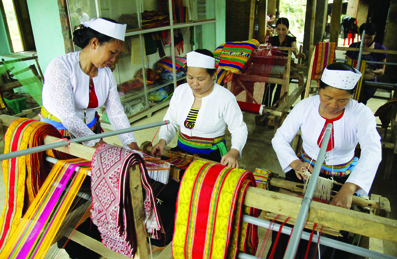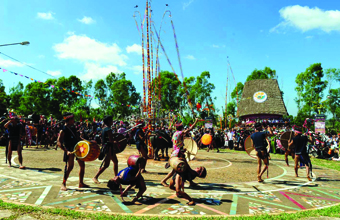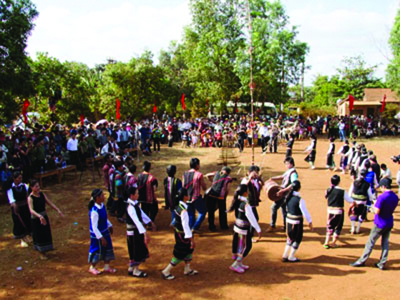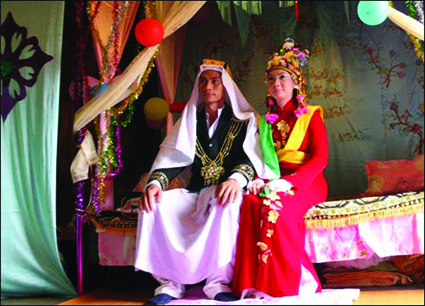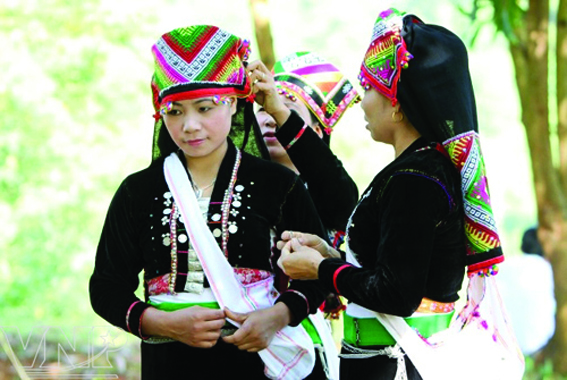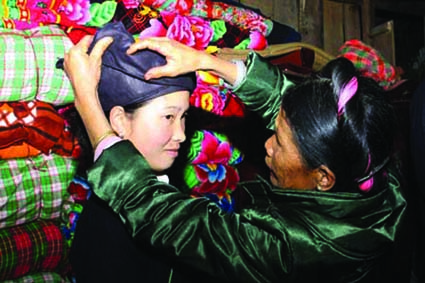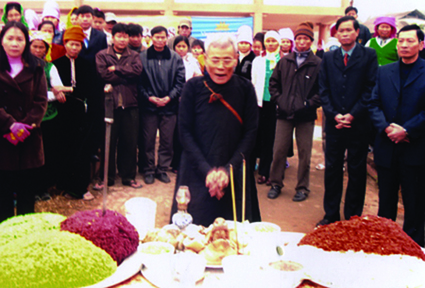>>New rice ceremony of the Thai
>>Matrilocality challenges Thai grooms
Ta Thi Tam
Ethnology Institute
As spring comes with apricot trees blossoming white in northwestern forests, Thai villagers flock to the home of their witch doctor to hold a special ceremony called xen lau no.
Xen lau no, which means offering rice wine in the bamboo shoot season in Thai language, is a unique ceremony dedicated to mo mot (witch doctor) who are highly respected in the Thai community for curing sick persons.
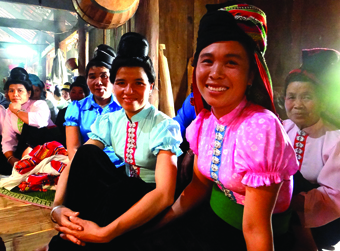 |
Thai women at Xen Lau No festival__Photo: Internet |
The ceremony is held for three days between the 3rd and 15th of the first lunar month at the home of the mo mot. It is an important event in the spiritual life of the Thai during which the group honors their original belief and cultural traditions.
Xen lau no has two parts. The first involves rituals to worship the gods of river, mountain and land and the ancestors of witch doctors and to give thanks to witch doctors for their help. The second includes festive activities like singing, dancing and playing folk games.
The date of holding xen lau no is chosen by the mo mot and informed to his foster children, who are the patients the mo mot has cured. According to Thai custom, the mo mot must invite in person, showing his sincerity, his patients to the ceremony.
At xen lau no, worship rituals are conducted at the altar dedicated to the ancestors of the mo mot. Hung around the altar are shirts of different sizes and colors sent by foster children, which symbolize their spirits, implying that the patients completely trust in the talent and virtue of the mo mot. When a patient or the mo mot dies, his relative must bring offerings to the mo mot’s, asking for permission to take the spirit of the dead home.
Several days before the ceremony, the mo mot’s foster children gather in his home to prepare the ceremony. The most important preparation is to set up xang boc (flower tree) - an indispensable object of the ceremony - at the altar in the home of the mo mot. This work needs skillful persons as xang boc is really a piece of art. Made from a bamboo or banana tree, xang boc is stuck with thin bamboo sticks arranged in either seven or nine layers. Each bamboo stick whittled to a sharp point is decorated with colorful paper flowers and bamboo leaf-made animals like cicada, bird and fish. At the foot of xang boc are placed a jar of rice wine, a bunch of bananas, other fruits, fresh bamboo shoots and farm produce such as rice, corn, pumpkin and squash, as offerings. It is believed that the more offerings under xang boc are, the more patients the mo mot will save in the new year.
To make offerings for the ceremony, the mo mot has to sacrifice a pig and a lot of chickens which have been raised carefully by the mo mot himself. Other essential offerings at xen lau no are rice wine and bitter bamboo shoots which symbolize spring and vitality.
Offerings on the tray placed on the altar include the head and hindlegs of a pig, a boiled rooster, grilled fish, sticky rice in green, red and purple, vegetables, bamboo shoots, a piece of white cloth, some silver bracelets and money.
Apart from the offerings prepared by the mo mot, each foster child prepares his or her own offerings to pay tribute to the mo mot who will pray for health and peace for the child’s family in the new year. These offerings typically include a boiled chicken or pig, a bunch of bananas, a plate of sticky rice, a pair of banh chung (sticky rice cake with pork and green bean fillings), a bowl of rice, a bottle and two cups of wine, three fishes, three pieces of bitter bamboo shoots, two strings, two pieces of sugarcane, three meters of cloth and some money.
Each foster child also prepares a pair of flower-embroidered white scarves with colorful fringes to be hung on xang boc. The more scarves are hung on the tree, the more prestigious the mo mot is as they show the number of patients the mo mot has cured. Hanging scarves on xang boc is the way the mo mot reports to his ancestors on his achievement and ask for their support to help more people.
To conduct xen lau no, the mo mot will need help from other mo mot in the village. The invited include a female who will assist the host in conducting the ceremony and two males who will play flutes in the ritual. The host mo mot must wear a ritual costume exclusively used for xen lau no, which consists of a shirt or dress, a robe, a belt and a hat.
Xen lau no starts with a ritual to invite gods and ancestors from heaven to the ceremony. The host mo mot and his assistants sit in a line in front of the altar and under xang boc with the two flute players sitting at two sides. The mo mot unfolds a fan, flaps it gently and starts singing a song to invite the gods to the ceremony. The singing accompanied by the flutes tells numerous hardships suffered by the mo mot and his foster children in their long journey to heaven to invite the gods of river, mountain and land and his ancestors to the ceremony. After singing, the mo mot picks up some divine sticks and counts them. If the number of the sticks is odd, it means the invitation fails and the mo mot has to sing the song again until he gets an even number of divine sticks.
This ritual is followed by another conducted by the mo mot to pray for health and peace for every foster child. Each foster child holds his own tray of offerings when the mo mot recites prayers, asking for the gods’ support for the foster child and his family. Finishing praying, the mo mot uses magic on the bracelet and necklace of the foster child and put them on the child. After that, the mo mot receives half of the foster child’s offerings and returns the rest to the child. This ritual can last for the whole day as the number of foster children may reach tens to a hundred.
When this ritual finishes, the mo mot and foster children together have a feast with the offerings of the ceremony. The party is followed by festive activities with people singing and dancing to the sound of drums and gongs throughout the night. In this part, the mo mot also plays an important role as he leads people in the dance to show his divine capacity.
Closing xen lau no is xong mot - a ritual to see off the gods to heaven - when the mo mot recites prayers to ask for the gods’ permission to close the ceremony and to win their support for a year of health, peace, happiness and prosperity for all villagers. In this ritual, the mo mot picks up the stuffs on xang boc and throws them to villagers, then dances with two hands held upward, implying to see off the gods to heaven.
After three days of the festival, villagers return to their everyday life with hopes for a new year of best luck.
Xen lau no is an original belief activity of the Thai to honor witch doctors who are not only the spiritual leaders of the Thai community but also folklore singers and dancers who help promote and preserve the group’s cultural values.-
